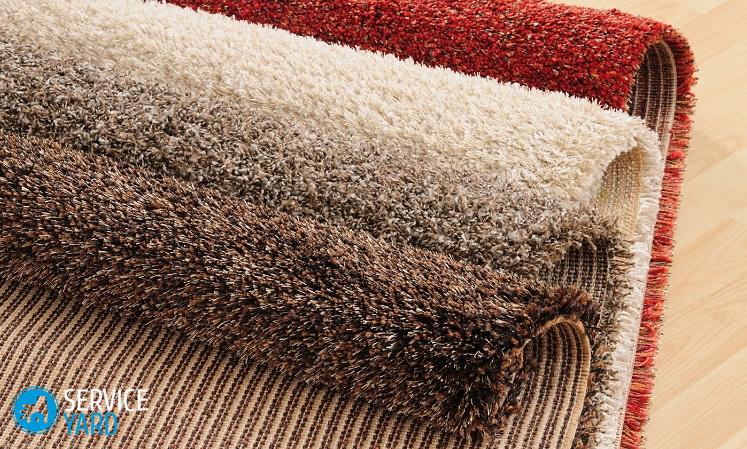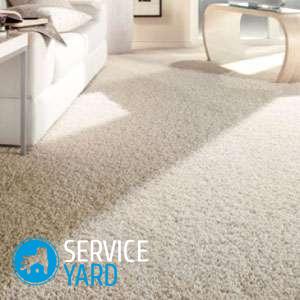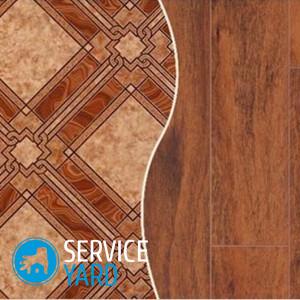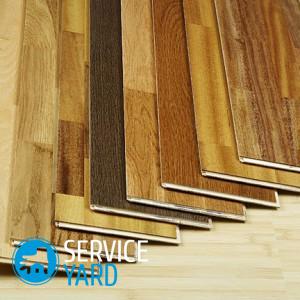Types of carpet
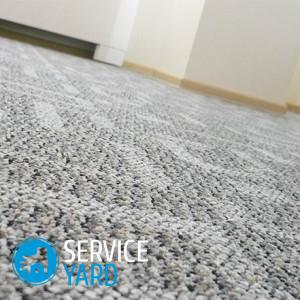
Carpet is a cozy and fluffy floor covering, which is used in a variety of rooms, residential and public. If earlier coatings made of carpet material were considered an indicator of high prosperity and were luxury goods, today they are accessible to literally everyone. High strength, ease of maintenance and styling, aesthetic appearance - these are the main advantages of this coating. In the article, we consider the main types of carpet, especially the manufacture and use.
to contents ↑Kinds
Distinguish products on a single and double layer basis:
- A single-layer base is a high-density synthetic fiber fabric with woven fibers.
- If you consider in the context of a coating with a two-layer base, then, in addition to the pile and the fixing layer, two bases are clearly visible.
Important! The width of the carpet is 4 or 5 m.
The carpet creates an atmosphere of comfort and warmth, it is an excellent sound and heat insulator. Artificial materials are not expensive at all. They are universal, suitable for laying in any room, with the exception of rooms with a high level of humidity (for example, a bathroom).
to contents ↑Important! Carpet is also not without some drawbacks. Sometimes there are difficulties with leaving, some varieties of flooring provoke allergic reactions.
Manufacturing methods
Consider the types of carpeting, depending on the manufacturing technology used.
Woven
Weaving is the oldest carpet making process. On the basis of jute knots of colored or plain yarn are tied, and then the ends of the yarn are trimmed. This technology is used in the production of Persian carpets, known throughout the world. The quality of the woven products is excellent, but the cost is high, because the production uses natural materials.
Tufted
Tufted manufacturing technology is also called needle-sewing. The needle along with the thread of the pile is displayed through the base. On the front side there are loops of a given height. They are cut and fixed with a secondary base from the inside. as a secondary base used:
- Jute is a natural, environmentally friendly material. However, with prolonged use, the jute base wears out. In addition, the material does not differ in increased water resistance - when water enters, the base begins to rot. In addition, jute shrinks when wet.
- Felt. This is a relatively innovative synthetic material that resembles the appearance of felt. Such a base retains heat well, is comfortable, and is moisture resistant. The edges of the material do not crumble when cut.
- Action back - synthetic fiber jute, devoid of the disadvantages inherent in natural material. Synthetic jute base is durable, resistant to moisture. However, laying carpets on this basis on top of the parquet is impossible, due to the fact that the fiber is very stiff.
- Rubber. The rubber base is mainly used for carpet in rooms with high traffic.
Needle-punched
In the manufacture of tufted fabric, special needles with notches along the entire length are used instead of ears. With a long movement down and up, the needle mixes the threads in the most bizarre way. It turns out a canvas, similar to felt.
Compared to woven or tufted products, the durability of needle-punched carpeting is higher.It is perfect for rooms with high traffic, and its price is low.
Important! Another positive quality is the high level of sound absorption. Due to its good sound absorption and durability, it is used in entertainment enterprises (theaters, cinemas).
Flocked
Flocking is the most advanced production technology. Flocking is the fusion of fibers into a polyvinyl chloride substrate using an electric field. The carpet is pleasant to the touch, smooth, resistant to wear and moisture.
to contents ↑Criterias of choice
According to experts, it is necessary to choose a carpet based on such criteria:
- For the living room - multilevel or tufted coating. A carpet with a short hair is well suited.
- In the bedroom there is a carpet with a large fluffy pile.
- In the kitchen - needle-punched colorful cloth.
- For the bathroom - flocked flooring.
- In the hallway - needle-punched cloth impregnated with a water-repellent composition.
- In the office or on the loggia, a wicker product made of natural exotic material will be optimal.
Carpet composition - types of materials
It happens that a person liked the appearance of the product. He immediately buys it, without thinking about what materials the product is made of. However, many characteristics of carpet are hypoallergenic, strength, and durability. determined by the material from which the product is made.
Natural yarn
It can be of animal (wool) or vegetable origin (coconut, cotton, flax fiber). Most often, pure wool or mixed fiber with a natural material content of 10 or 30% is used to make carpet. Woolen fiber is warm, elastic, durable, has a good soundproofing effect, is safe against fire.
However, there are also disadvantages. The material accumulates a static charge, is not resistant to moisture, is afraid of moths. Fiber with a wool content of 10-20% is classified as natural. Woolen carpets are the most expensive, and their price rises with an increase in the percentage of natural material.
Important! You can distinguish a woolen villus from a synthetic one if you set it on fire. The synthetics melt, and the wool smolders slowly, emitting a specific smell.
Artificial fiber
With the development of modern technology, the number of varieties of fiber obtained as a result of chemical reactions is constantly growing. Products made of chemical fiber are resistant to wear, unattractive to parasites, and have a relatively low cost. Consider the most common types of artificial fibers.
Polyamide (Nylon)
Nylon is characterized by high strength, resistance to deformation and wear. The nylon carpet retains an attractive appearance for a long time, the pile perfectly withstands the severity of the situation. Thanks to antistatic treatment, polyamide fiber does not accumulate electricity.
Polyester
Fiber polyester resistant to mechanical stress. The material is not attractive to microorganisms, resistant to fire. Compared to nylon products, polyester-based carpeting is cheaper. It is characterized by a kind of “synthetic” shine.
Outwardly, polyester resembles a woolen pile, but is significantly inferior to natural material in terms of performance. Polyester is durable, retains heat not bad, but not as elastic as natural wool or acrylic canvas.
Polypropylene
Unlike nylon, it does not accumulate static electricity, however, it is combustible and wears out relatively quickly. For this reason, in public institutions polypropylene coatings are not used. The main advantage of the material is its resistance to staining (the exception is oil stains).The color of the product is set during the manufacturing process, since the fiber is dyed quite poorly.
Important! Polypropylene carpet is moisture resistant and does not lose color from exposure to sunlight. It is used in the arrangement of artificial lawns.
Currently, 2 more varieties of polypropylene fiber (suprim, terclone) have been created, with greater resistance to wear than the basic version.
Acrylic
Acrylic wear resistance is average. Therefore, acrylic fiber in the manufacture of carpet flooring is often mixed with other types of fibers, due to this, the wear resistance is significantly increased.
A separate category is mixed fibers. This is a mixture of several types of synthetics or wool with synthetics in various percentages.
to contents ↑Important! When buying a carpet, do not forget to ask not only the percentage of wool, but also the type of artificial fiber used. Different types of synthetics have different operational properties, pluses and minuses.
What does a carpet look like? Classification by weaving method
There are floor carpets and pile height:
- Short - 2-5 mm.
- The average is 5-8 mm.
- High - more than 8 mm.
Important! In addition to pile height, an important indicator of product quality is its density. It is the density of the pile that determines the resistance of the product to abrasion, durability.
The pattern can be obtained not only using multi-colored fibers, but also by varying the height of the pile. In this regard, distinguish between single and multi-level coatings.
Velours
One-level coating with fluffy tips of the villi. Thanks to this, the material is very pleasant to the touch. The velor fabric is plain, so the spots on it are quite noticeable. However, the material is excellent to clean.
Important! This is a good choice for a kids room, bedroom or living room.
Frize
This is a carpet with a high twisted pile, “curly” in appearance. Special heat treatment helps maintain shape. The most common is a two-factor web of fibers with different thicknesses of carpet. It is resistant to creasing.
Important! The “frieze” carpet with a print printed on it looks beautiful. Such products are great for children.
Scroll
This is a multi-level coating formed by single villi, as well as loops of various lengths. Unusual, beautiful canvas, moreover, is resistant to wear.
Important! It can withstand heavy loads, so it is suitable even to put in the hallway.
Katlup
Another kind of multi-level canvas. It is a combination of low loops and a sheared pile.
Important! Katloop is well suited for the bedroom.
Shaggy
Shaggy is a carpet with long and thick villi. The villi are twisted and resemble a miniature sharpened pencil. They do not merge with each other.
Important! Carpet “shaggy” - ideal for a child’s room.
Saxony
For the manufacture of this coating used twisted yarn. The pile is sheared, but the surface has a peculiar “grainy” appearance. The Saxony product is distinguished by its beautiful appearance, ease of care and comfort.
Berber
Very unusual and beautiful carpet, formed by loops with different heights. The fact that the hinges differ from each other in shade or color gives the product a particularly elegant look.
to contents ↑Important! When choosing this type of flooring, follow the instructions for installing it. To do this, our article will help you. "How to connect a carpet?".
Care Features
Caring procedures are not particularly difficult. Thanks to proper care, the carpet will retain its characteristics and attractive appearance for a long time:
- Clean the product weekly.
- If the flooring is made of natural fibers, never use a washing vacuum cleaner. The villi will absorb moisture, and it will be very difficult to dry the product.
- It is recommended that you clean a natural carpet with a vacuum cleaner with a rotating electric brush. The best option is dry cleaning.
- The frequency of cleaning an artificial product is the same as a natural one. You can use a washing vacuum cleaner, but wet cleaning should not be abused either. Otherwise, a layer of dirt-repellent impregnation can be destroyed.
Dry cleaning
The frequency of dry cleaning - 1 time in 6 months. Doing dry cleaning yourself is better not to try. In the best case, the carpet will lose its former attractiveness, in the worst - it will just have to be thrown away. The best option is to call home specialists who will help with cleaning.
Print spots
Even with the most careful handling of the floor covering, stains form on it. If you purchased a carpet, it makes sense to get the whole arsenal of means for removing stains. Using special tools in accordance with the instructions, you can cope with almost any stains. Exceptions are traces of paint, rust or shoe polish - only dry cleaning can handle them.
to contents ↑Important! If you haven’t decided yet, you will precisely lay the carpet or can choose another floor covering, then also look at the information from our following reviews:
Stock footage
In this article, we examined all types of carpet and their differences. We hope that now it will be much easier for you to understand what cover to choose for a particular room in your house.





